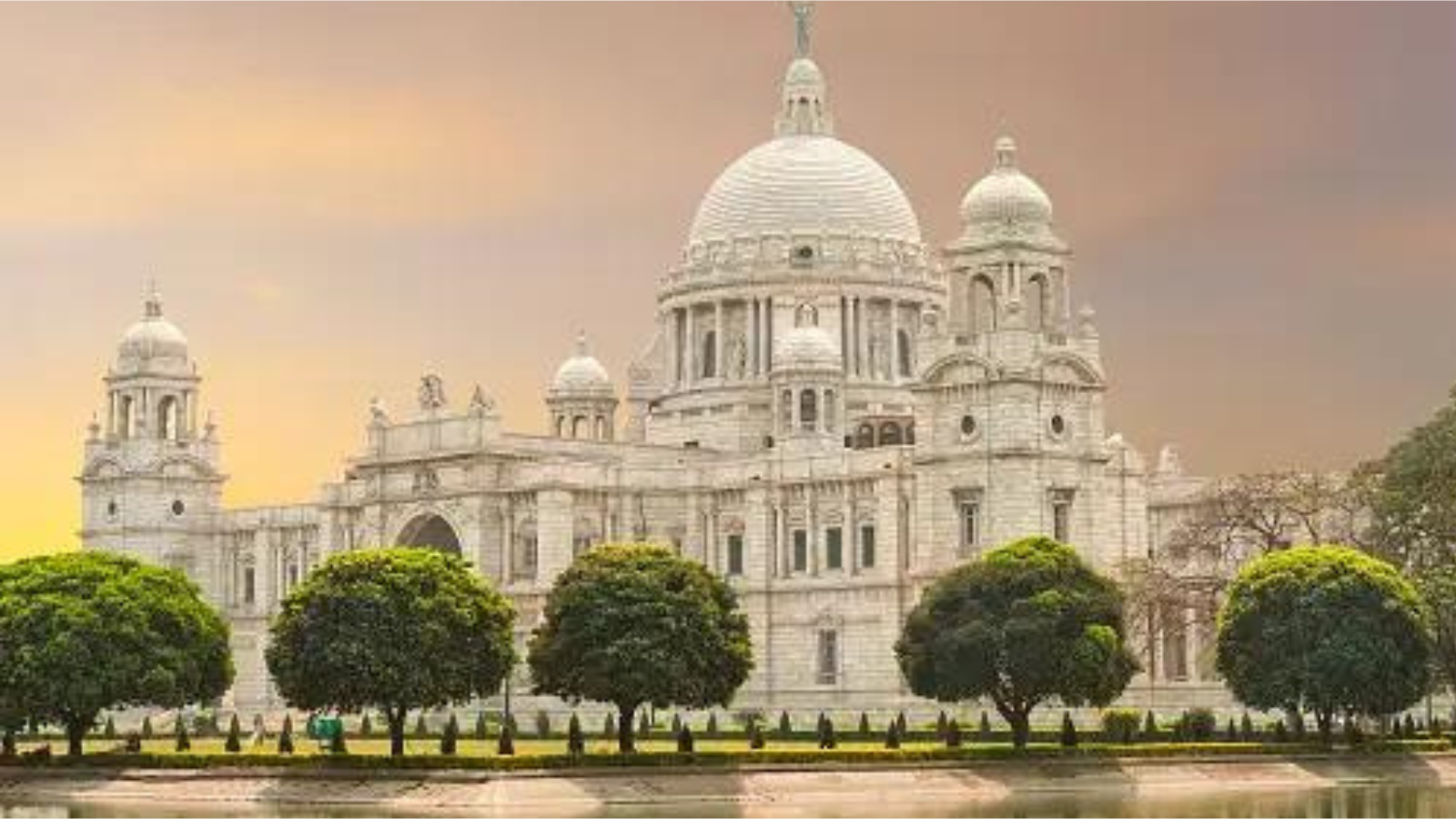
The Victoria Memorial is a sizable marble structure with an entrance on Queen’s Way located on the Maidan in the heart of Kolkata. It was constructed by the Indian government between 1906 and 1921. It honors Victoria, who reigned as Empress of India from 1876 to 1901. It is the greatest monument to a monarch anywhere in the globe and is now a museum run by the Ministry of Culture. It is situated on 64 acres of grounds. It has developed into one of the most well-liked sights in the city, displaying notable characteristics of the Anglo-Indian architecture of the imperial era.

History:
After Empress Victoria passed away in January 1901, Lord Curzon, the Viceroy of India, proposed that Kolkata, now known as Calcutta, the capital of India, build a suitable memorial to the late Queen-Empress. He suggested creating a large structure complete with a museum and gardens. Curzon remarked,
“Let us, therefore, have a building, stately, spacious, monumental and grand, to which every newcomer in Calcutta will turn, to which all the resident population, European and Native, will flock, where all classes will learn the lessons of history and see revived before their eyes the marvels of the past.”
Lord Curzon made a plea for money, and the government officials, princes, politicians, and citizens of India generously answered. The monument’s construction cost of one crore, five lakh rupees was totally covered by their voluntary donations.
The location picked was close to what was then known as Government House and is now known as Raj Bhavan. Curzon’s departure from India in 1905 caused a delay in the building of the Victoria Memorial, which led to a decline in local support for the undertaking. Testing was done on the foundations since there was some doubt regarding their stability.The new Prince of Wales lay the cornerstone on January 4th, 1906.
Work on the superstructure started in 1910 when Messrs. Martin & Co. of Calcutta were given the building job.
George V, the then-emperor of India, declared the move of the country’s capital from Calcutta to New Delhi in 1912, before the project was completed. As a result, the Victoria Memorial ended up being built outside of the national capital, in a significant provincial capital.
In 1921, the Victoria Memorial was finished and publicly unveiled to the public.
A few changes were made to the Memorial after 1947.
In the Hardoi District, a smaller Victoria memorial was also built; it has subsequently been transformed into a city club for leisure. In the 1930s, Mahatma Gandhi spoke at gatherings in Hardoi.
Design and architecture:
William Emerson (1843-1924), who designed the Victoria Memorial, was its architect. The architecture is in the Indo-Saracenic revivalist style, which combines Venetian, Egyptian, and Deccani architectural inspirations with British and Mughal components. The structure has a base measurement of 338 by 228 feet (103 by 69 m) and a height of 184 feet (56 m). The building’s material is white Makrana marble. David Prain and Lord Redesdale created the Victoria Memorial’s grounds. The north aspect bridge and the garden gates were created by Emerson’s associate Vincent Jerome Esch. Emerson hired Esch in 1902 to draft his initial design for the Victoria Memorial.
The 16-foot (4.9-meter) tall Angel of Victory statue is perched atop the Memorial’s main dome. Allegorical statues depicting art, architecture, justice, and charity are positioned around the dome, and motherhood, prudence, and learning are shown above the north porch.
White Makrana marble was used to construct the Victoria Memorial. With its dome, four subsidiary, octagonal-domed chattris, lofty portals, terrace, and domed corner towers, it is similar to the Taj Mahal in style.
Museum:
There are 25 galleries in the Victoria Memorial. These include the central hall, the sculpture gallery, the arms and armory gallery, the modern Kolkata gallery, the royal gallery, the national leader’s gallery, the portrait gallery, and the gallery of portraits. The biggest collection of Thomas Daniell’s (1749–1840) and his nephew William Daniell’s (1769–1837) works may be seen at the Victoria Memorial. As addition as having a collection of rare and ancient literature, it also contains volumes on kathak dance and thumri music by Nawab Wajid Ali Shah, the illustrated works of William Shakespeare, the Arabian Nights, and the Rubaiyat by Omar Khayyam. The memorial’s programmatic components, such as the galleries and their exhibits, do not, however, compete with the spaces or voids that are purely architectural.
Victoria Gallery:
The Victoria Gallery has various portraits of Queen Victoria and Prince Albert as well as works by Winterhalter, Frank Salisbury, and W. P. Frith that depict their life.[17] These are reproductions of English works of art. Among these are Victoria’s coronation at Westminster Abbey in June 1838, her marriage to Prince Albert in the Chapel Royal at St. James’s Palace in 1840, and the Prince of Wales’ baptism in St.paintings of Victoria at the services for her Golden Jubilee at Westminster Abbey in 1887 and her Diamond Jubilee ceremony at St. Paul’s Cathedral in June 1897, as well as the wedding of the Prince of Wales and Alexandra of Denmark in 1863. George’s Chapel, Windsor Castle, was completed in 1842. The room’s attraction is a rosewood pianoforte from Queen Victoria’s youth that her son Edward VII donated to the Victoria Memorial, together with her Windsor Castle writing desk. Vasily Vereshchagin’s oil painting representing the state entrance of the Prince of Wales into Jaipur in 1876 is on the south wall.
Gardens:
A group of 21 gardeners care for the 64 acres (260,000 m2) of grounds at the Victoria monument. Redesdale and David Prain created them. A bronze statue of Queen Victoria, designed by George Frampton, is located on Esch’s bridge between Goscombe John’s narrative panels. Victoria, the Empress, is seated on her throne. adjacent sculptures honoring Hastings, Charles Cornwallis, 1st Marquess Cornwallis, Robert Clive, Arthur Wellesley, and James Broun-Ramsay, 1st Marquess of Dalhousie may be seen outside the structure and in adjacent paved quadrangles.The Edward VII monument arch is located south of the Victoria monument building. Both a marble statue of Curzon by F. W. Pomeroy and an equestrian bronze statue of Edward VII by Bertram Mackennal may be found in the arch. The garden also has sculptures of Rajendra Nath Mookerjee, a forerunner in Bengali industry, George Robinson, 1st Marquess of Ripon, and Lord William Bentinck, governor general of India (1880–1844).[4] A small number of people voiced opposition to the West Bengal High Court’s decision to levy an entrance charge for the gardens, while the majority of people supported it.



